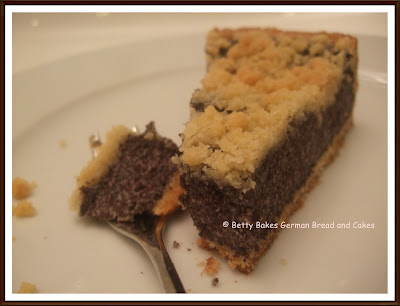And here it is: my final German Christmas biscuit recipe for the year (I'll be back in January and I promse there won't be any new-year-resolution diet recipes from me). Spitzbuben are another ‘must have’ recipe in every self-respecting Christmas biscuit fanatic’s tins. I have no idea why they are so oddly named or what their origin is, but I do know one thing for sure: they are very good. Spitzbuben are traditionally cut out with a fluted round cutter and filled with either jam or chocolate. However, other shapes are also possible, of course, as the hearts in my picture below.
In Germany my favourite filling for Spitzbuben can be bought in every supermarket: this is called nougat, a paste made from chocolate and ground hazelnuts that tastes delicious. I have not yet found an equivalent for this in the UK. I guess it would be called something like a praline paste, but nothing of the kind seems to be commercially available. A good replacement for German nougat is a mixture of milk chocolate and Nutella (or another chocolate spread) melted together. Alternatively, I have used chocolates with a soft praline filling, such as Lindor or those Belgian sea-shell shaped chocolates. I don’t recommend using just plain chocolate or plain Nutella, as this would be either too hard or too soft. For Spitzbuben filled with jam it is easiest to heat up the jam slightly to make it more spreadable. I also pass it through a sieve if it contains large pieces of fruit. Biscuits filled with jam need to be dried overnight or at least a good few hours in a cool place before they can be put away.
The recipe makes about 60 double biscuits:
375 g flour
½ teaspoon baking powder
200g sugar
Seeds of one vanilla pod
250 g butter
125 g ground hazelnuts
1 egg yolk
For the filling: praline paste (see above) and/or jam of choice
Mix all ingredients until combined in a ball of pastry. Wrap in cling film and leave to rest in the fridge for at least 2 hours or overnight. Roll out the dough very thinly between two layers of cling film. Cut out biscuits with a round fluted cutter or another shape. Transfer onto a baking sheet covered in baking paper. Bake at 180 degrees for about 7-10 minutes, depending on the size and thickness of the biscuits. The biscuits should not turn brown, only very slightly golden.
Leave to cool before removing from the baking sheet. Then sandwich the biscuits with praline paste or jam. It is easiest to place a blob of filling in the middle of one biscuit and then very slightly press down the second biscuit until the filling has spread to the edges. Leave the biscuits to dry until the filling has firmed up. Dust with icing sugar and store in a tin.












































